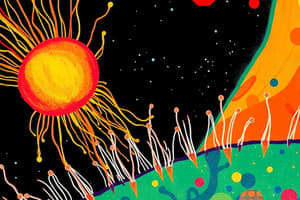Podcast
Questions and Answers
What physical feature restricts the sliding of the doublets in the flagellum?
What physical feature restricts the sliding of the doublets in the flagellum?
- Ciliary fibers
- Radial spokes (correct)
- Intermediate filaments
- Anchoring proteins
What type of movement occurs when the flagellum undulates from the base to the tip?
What type of movement occurs when the flagellum undulates from the base to the tip?
- Pulling force
- Lateral movement
- Pushing force (correct)
- Gyration
During which type of flagellar movement does the organism rotate in the opposite direction?
During which type of flagellar movement does the organism rotate in the opposite direction?
- Effective Stroke
- Spiral Undulation (correct)
- Undulation
- Sidewise Lash
Which of the following describes the effective stroke of flagellar movement?
Which of the following describes the effective stroke of flagellar movement?
What movement causes the organism to pull forward?
What movement causes the organism to pull forward?
Study Notes
Structure and Function of Flagellum
- Doublets of the flagellum are held in place by radial spokes, limiting sliding between them.
- The constrained structure allows the doublets to curve, contributing to flagellar bending.
Flagellar Movements
-
Undulation Movement:
- Waves travel from the base to the tip, generating a pushing force that propels the organism backwards.
- Movement from tip to base generates a pulling force, allowing the organism to move forward.
- Lateral movement occurs when the flagellum undulates to one side, causing the organism to drift in the opposite direction.
- Spiral undulation results in rotational movement known as gyration, turning the organism in the opposite direction.
-
Sidewise Lash Movement:
- Characterized by paddle-like beats, this movement consists of two strokes: effective stroke and recovery stroke.
- Effective strokes contribute to propulsion, while recovery strokes help reposition the flagellum for the next effective stroke.
Studying That Suits You
Use AI to generate personalized quizzes and flashcards to suit your learning preferences.
Description
This quiz explores the intricate structure of the flagellum, particularly the role of doublets and radial spokes in its movement. Understand how bending and undulation contribute to flagellar propulsion in organisms. Dive into the mechanics of flagellar function and its biological significance.



